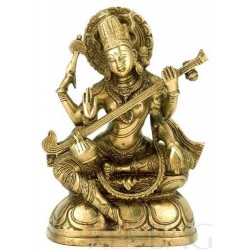
A truly significant or constructive event often does not receive any attention beyond the limited sphere of its happening and such an event took place in Trivandrum, Kerala, at St. George’s Orthodox Syrian Church. It was the day of Vijaya Dasami, the festive and sacred occasion commemorating the victory of the Divine Mother over the hostile forces, a day which is observed in Kerala for centuries as the Vidyarambham or the day when children are initiated to learning. This was the first ever time a Church promoted the event, launching forty children, four of them Hindus and thirty six Christians, into education, in harmony with the wider ethos prevailing in the state. Needless to say, there is massive goodwill and understanding behind the gesture.
It is not that rituals are terribly important, but symbols are. No civilisation worth its name can either dispense with its symbols or surrender them to a particular religious faith. Unfortunately in India the non-Hindu intellectuals have developed the tradition to do exactly that. They have surrendered to the Hindus the invaluable treasures of their national heritage and have deprived themselves of their most vital identity. Behind the symbols lie vast experiences, revelations and wisdom that are universal. To ignore this is not wisdom of any kind, material, secular or otherwise, but a deplorable bankruptcy of the spirit of education. Ironically, it was a group of education ministers of some of the Indian states who demonstrated this bankruptcy some years ago – in October 1998 to be precise – when they walked out of a conference convened by the Ministry of HRD, protesting against a formal invocation to Saraswati, the goddess of arts, science and culture. The language in which they voiced their protest was the common mother tongue of the average Indian politician – shrieks and shouts. How much one wishes that they had sat quiet, plugging their ears for a couple of minutes the Vandana was to last. Alas, they were keen to educate us in norms and behaviour that characterise Indian politics today.
Some teachers who met this author soon thereafter – and they included a Muslim – observed, “Once again the ministers, forgetting that they were education ministers but alert to the sole fact that they belonged to a certain political party which championed a strange brand of secularism, created a deplorable precedence. This may snowball down numerous other educational fora.”
I can remember several occasions when I happened to be the speaker and a Muslim or a Christian celebrity chaired the meet. They would stand up with reverence when a similar invocation was sung and if the performance was good, would whisper to me their appreciation of it. Presiding over a meeting in Jodhpur – in 1978 if my memory serves me right – Prof. V.V. John, educationist, author and Member (Chairman?) of the Minority Commission, called out to a former student of his in the audience to recite a Rig Vedic hymn which he adored, when he saw no provision for an invocation in the programme.
Even if we do not expect the ministers to be aware of the mystic import of Saraswati, they should have known about the historical genesis and psychological significance of Saraswati. The concept came into being long before the current connotation of Hinduism came to prevail, long before the term Hinduism was coined, and long before the ritualistic, political, superstitious and popular ideas that go with Hinduism came into vogue. Saraswati was presented to us by the Rig Veda, the earliest systematically composed document of human quest and aspiration in the world. Saraswati is the personification of creative inspiration and expression; she is beautiful, dignity and poise marking her figure and pose, holding a Veena and a book in her hands and attended upon by a swan. She symbolizes harmony and grace – and her charming swan the flights of creative inspiration. A symbol is a symbol. Minerva is never disrespected even though the Greeks have changed their religious faith. Minerva belongs to Greece and mankind, just as Saraswati belongs to India and mankind.
To colour Saraswati with the post-partition communal outlook, to refuse to listen to a hymn in her praise is as silly as counting the sun, the Ganga and the Himalayas among the Hindus and refusing to bask in the sunlight, look at the Himalayas and bathe in the Ganga. I wish the Education Ministers could achieve such feats.
It is time when we are educated enough to draw a line between our national heritage – which is also the heritage of humanity – and the Hindu religious faith. What is wrong with the proposal to acquaint our students with the Vedas, the Upanishads and Sanskrit? Can anyone deny the fact that these are the treasures that constitute the basis of Indian culture? Can we imagine Indian literature sans the Vedas and the Upanishads? Can we fantasise that a Valmiki, a Vyasa, a Kalidasa, a Tagore or a Bharati would have been possible all the same without them?
The Syrian church in Kerala, (by the way, the Syrian Christians are the earliest Christians in India), though bearing the name Orthodox, has proved to be progressive in trying to liberate the symbolism of Vijaya Dasami from the limitations into which it was traditionally consigned.
Manoj Das
(Manoj Das is an internationally known creative writer. He is the recipient of India’s national recognition, the Sahitya Akademi Award and the nation’s most prestigious literary award, the Saraswati Samman. As a social commentator, his columns in India’s national dailies like The Times of India, The Hindustan Times, The Hindu and The Statesman, revealing the deeper truth and the untraced aspects behind current issues, have been highly appreciated.)





